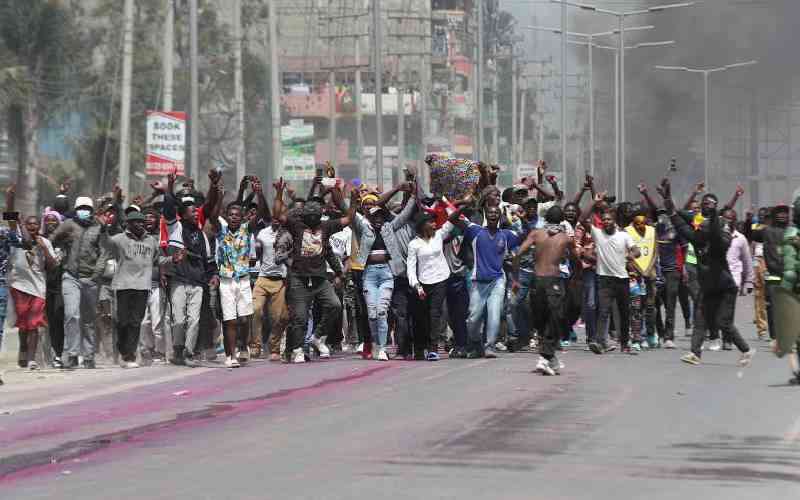The Gen Z-led protests that have surged across Kenya-including in the Saba Saba demonstrations on July 7, 2025—represent a seismic civic awakening. Young Kenyans have confronted the political establishment with an uncompromising call for accountability—on corruption, police brutality, and poor governance.
Yet, disturbingly, senior government officials have responded not with introspection, but with an old and dangerous tactic: ethnicisation. No longer just government-aligned voices—now those at the very apex of state power are suggesting that the protests are regionally or ethnically driven, rather than reflecting the breadth of national discontent. By casting the protests as an expression of tribal grievance rather than national outrage, the political elite hopes to divide, discredit, and derail a transformative movement.
In 1966, the government of Jomo Kenyatta employed this approach against Jaramogi Oginga Odinga’s Kenya People’s Union (KPU). By deploying divisive rhetoric and state-sponsored violence, the KPU was confined to Luo Nyanza. When Bildad Kaggia—Odinga’s deputy and a Kikuyu—lent the KPU a more national face, he was imprisoned in 1968, effectively deterring cross-ethnic engagement and allowing the government to portray the party as an ethnic enclave. In doing so, the Jomo government reduced legitimate concerns over growing inequality and government’s lack of accountability into an ethnic grievance boxed into Luo Nyanza.
The Moi regime refined the practice. In the early 1990s, as Kenyans agitated for multiparty democracy, the state arrested key reformists—Paul Muite, Martin Shikuku, James Orengo, and George Anyona—and transported them to their ethnic “homelands” for showcase prosecutions. It was a calculated move to reduce national figures to ethnic actors, undermining their legitimacy and fracturing popular support.
The objective of these tactics is clear: to divide Kenyan’s by framing civic dissent as a threat to a specific community’s leadership. The result is that individuals who share in the grievances are pressured to withdraw support in defense of their ethnic identity. Reformists are branded as traitors. National unity dissolves into mutual suspicion, and the momentum for reform collapses under the weight of ethnic divisions.
The dangers are significant. Most immediately, this ethnic framing shifts focus away from the substantive issues that triggered the protests in the first place. Calls for transparency, justice, and equitable governance—shared across all communities—are drowned out by emotionally charged tribal rhetoric. The broader public is distracted. The political elite escapes scrutiny.
Worse still, such framing empowers ethnic strongmen. Once civic movements are neutralised through tribalism, these so-called ethnic spokespersons emerge as brokers of political power. They claim to speak for “their people” while using that platform to negotiate personal advancement. The cycle of unaccountable leadership continues, while citizens remain trapped in an endless loop of ethnic competition and institutional failure.
To prevent this outcome, decisive action is needed.
First, the Gen Z protesters must remain unwavering in their rejection of ethnic framing. They must refuse to be divided along tribal lines. The pre and Saba Saba July 7 protests were remarkable not only for their scale, but for their unity—young Kenyans from every corner of the country, identifying offline and online not for tribe, but for truth. That unity must be preserved.
Second, political figures who have previously suffered from ethnic profiling must speak out. Former Prime Minister Raila Odinga, who was himself once branded a tribal leader to undermine his national message, must denounce any members of his party who deploy this same divisive tactic against the current generation. Silence, in this moment, would be complicity.
Third, the broader Kenyan public must stand in solidarity with the youth. The issues being raised—poverty, corruption, unemployment, and repression—cut across every ethnic boundary. Citizens must reject the ethnic warlords who have historically weaponized tribe to shield themselves from accountability. Their time must come to an end.
Kenya is standing at a crossroads. The constitutionally protected protests are not just an echo of the past—they were a signal of a new political awakening, one that could redefine the future. The youth have spoken with clarity, courage, and purpose. Let us not allow the mistakes of history to muffle their voice. The stakes are too high. Kenya cannot let history repeat itself.
The authors are researchers on the history of rule of law in Kenya.
By Gilbert Muyumbu and John Mwendwa


